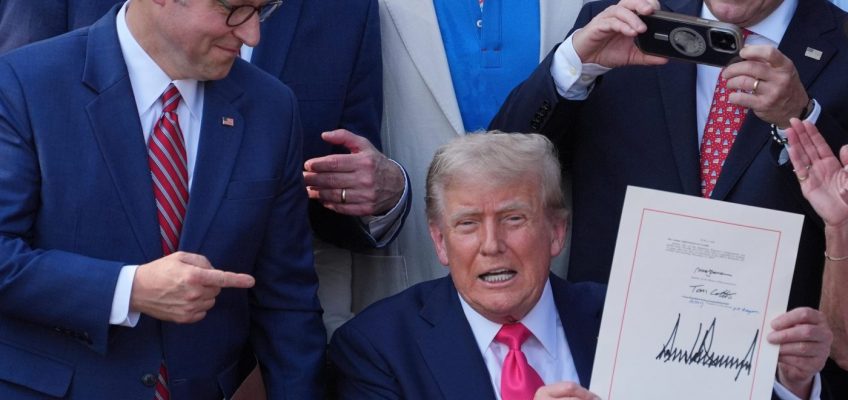For 35 years, the University of Minnesota Extension Service has funded nutrition education in low-income areas statewide, including innovative projects like the medicine garden at the Ramsey County Fairgrounds, which connects the county’s military veterans to a Native American grower and healer.
On Monday, all 59 of Extension’s full-time nutrition educators received termination letters, permanently ending the $7.2 million education and outreach program.
Extension issued letters to 700 partners Tuesday — from clinics and daycares to parks and food banks — explaining that heavy cuts to the federal Supplemental Nutrition Assistance Program, or SNAP, had forced the Minnesota Department of Children, Youth and Families to slash grant funding for the dozens of health and wellness coordinators who run special projects or teach healthy eating to SNAP-eligible families across the state.
The cuts are a direct result of President Trump’s “Big Beautiful Bill” approved last week by the Republican-led Congress. The eight tribal nations in Minnesota, alongside SNAP education programs nationwide, face the same straits as a result of the wide-ranging, 800-page budget document.
“Minnesota was a pilot program when it started 35 years ago. This is not temporary. It is a permanent cut,” said Patricia Olson, director of Extension’s Department of Family, Health and Wellbeing, which is based in St. Paul. “It is a national program. How do you wind down a program that is 35 years old?”
“We’re sad about losing staff, but also about the kind of work we were doing in the community,” she added.
The sweeping budget bill, which includes both spending cuts and tax cuts expected to add $3 trillion to $4 trillion to the national debt over the next decade, has already had repercussions for Minnesota and the East Metro, with deeper impacts likely as the legislation’s many varied provisions take effect over the coming months and years.
Implications for Medicaid
Nearly $1 trillion in cuts to state Medicaid allotments nationwide may not be fully implemented until 2027 or 2028, leaving big choices ahead for the state of Minnesota, which determines how federal Medicaid dollars are distributed, said Karen Kleinhans, chief executive of the Community Dental Care. The nonprofit, which maintains offices in Maplewood and four other locations across the state, charges low-income patients on a sliding scale; 88% of its clients are on Medicaid, while others are uninsured.
Kleinhans fears the state may roll back the increased Medicaid reimbursements that she and other safety-net dental care providers lobbied hard for in 2022, or make even deeper cuts. “We can’t predict what the state will do with the very limited dollars that will be coming to them,” she said. “If you are on Medicaid, you should just make sure you get some dental care before the end of this year, because you might lose those benefits.”
Minnesota is one of a handful of states where the counties conduct Medicaid screenings and connect seniors and the disabled to services. Facing screening backlogs as long as eight months or more, Ramsey County recently committed to hiring 80 new financial assistance workers, including 60 screeners. As a result of Trump’s budget, yearly screening requirements are doubling to twice-annually, moving a goal post that already was exceedingly difficult for some counties to reach.
“We’ve got to certify people twice a year. That’s a huge administrative burden,” said Rafael Ortega, who chairs the Ramsey County Board of Commissioners. “More people fall through the cracks, and that extra work requirement falls on counties in Minnesota.”
“We have no immediate plans, for the people we just hired to expedite financial assistance, to let those people go,” he added. “We budgeted for that, so we’re good for a while. The biggest impact is the people who are going to be cut off from Medicaid and are going to go through the emergency room.”
Ortega predicted a trickle-down effect for hospitals, nursing homes and other Medicaid-backed housing and care providers, who likely will see more patients lacking in medical coverage. Up to $500 million in annual reimbursements for hospitals and nursing homes could be eliminated, according to the League of Minnesota Cities.
“If we don’t verify people for Medicaid, and then they go to the hospital or nursing homes, that impacts reimbursements,” he said.
County officials still are reading through the legislation to get a grasp of it and bracing for changes that, in some cases, are well over a year into the future. “This bill pushes impacts out past the mid-term elections (in November 2026), so we have to figure out what happens when,” Ortega said.
Downtown real estate development
Real estate redevelopment also stands to be impacted, for both better and for worse, according to housing advocates.
Affordable housing developments often depend on federal low-income housing tax credits, which will be altered in “two meaningful ways,” Daniel Lightfoot, a spokesman for the League of Minnesota Cities, said by email Wednesday. The legislation creates a permanent 12% increase in certain housing tax credit allocations beginning in 2026, and it also alters the threshold for bond financing for the developments.
“It’s estimated that these changes will finance over 1 million additional affordable housing units nationwide over the next 10 years,” Lightfoot wrote.
At the same time, Minnesota cities — and St. Paul, in particular — are poised to lose redevelopment incentives aimed at renovating vacant buildings and boosting downtowns. The new legislation kills subsidies that helped developers more than meet city and state energy efficiency standards, undermining a carrot that groups like the St. Paul Port Authority have used to entice development downtown.
Ortega predicted those changes would come down disproportionately hard on affordable housing, but some developers foresee even tougher times ahead for all types of development in distressed areas like downtown St. Paul in particular, in an era where the road already was murky.
“In St. Paul and Minnesota, we have a range of energy efficiency standards and aspirations that cost more than a regular building renovation,” said St. Paul developer Jamie Stolpestad, who hopes to acquire some downtown properties through his family’s firm, Hedmark Holdings. “Based on the (Biden-era) Inflation Reduction Act, there were federal tax incentives and other subsidies that usually more than offset these costs. But with those largely stripped away under the BBB Act, property owners are left to face those costs without federal level subsidies.”
As a result of legislation Trump signed into law in 2017, profits from the sale of stocks, bonds, real estate and other assets can be invested, at significant tax savings, in real estate development projects located within distressed areas, or “Opportunity Zones,” of which St. Paul is home to 18 of the 19 zones located in Ramsey County. The new legislation makes that program permanent and expands it to rural areas, which could spell good news for some areas, Lightfoot said.
Still, of concern to some developers, Trump’s budget tightens eligibility requirements for the “O-Zones” by changing the definition of what constitutes a distressed area. Some fear downtown St. Paul may no longer qualify.
That’s because household incomes within the surrounding census tract previously were limited to 80% of “area median income,” with the statistical area spanning multiple counties, which inflates the average far beyond that of average incomes in St. Paul. Under the new legislation, that threshold drops to 70% of area median income.
“The old rules resulted in most of downtown sitting within qualified Opportunity Zones,” Stolpestad said. “Those incentives drove investors to projects like the Arlow Apartments, Marriott Courtyard Hotel and Ecolab University/Stella Apartments. But with the income standards shifting from 80% of AMI to 70% of AMI, I think all the existing downtown census tracts will lose eligibility.”
Electricity rates to rise?
Logan O’Grady, executive director of the Minnesota Solar Energy Industries Association, said the state’s solar industry began letting workers go even before Trump’s bill passed, in anticipation of a rocky road ahead. The legislation cuts major federal subsidies for solar power in Minnesota, from residential rooftop panels to mid-scale community projects, but the impacts will be felt far beyond industry workers and individual residential buyers.
That’s because Minnesota utilities are under state mandate to convert more of their energy supply to renewables, like wind and solar. Without federal subsidies to do that, they’ll likely pass on the cost of those projects to everyday ratepayers, or import more oil and natural gas from other states. In other words, electricity and home-heating costs are likely to go up for everyone.
“The reality is, all of us are going to see rates go up,” O’Grady said. “It’s really the worst time for us. If you look at all our of load growth projections over the next decade, they’re set to jump by a lot because of things like data centers and EV chargers.”
“I live in a community where a data center is being built in Rosemount,” he added. “When you have this massive load growth coming, and you have tools available to deploy rooftop solar and community solar and other mid-scale projects, and then you strip those away, that doesn’t make a whole lot of sense to me.”
Other impacts foreseen
Officials with the League of Minnesota Cities said Wednesday they’re still sifting through the details of the 800-page legislation, but it eliminates or reduces many of the programs authorized by the Biden administration through the federal Inflation Reduction Act, either by cutting them entirely or rolling back implementation dates. Environmental programs are a big target.
“The bill rescinds unobligated funding for a huge portion of IRA grant programs,” Lightfoot said by email, “including the Greenhouse Gas Reduction Fund, Environmental Justice Block Grants, Climate Pollution Reduction Grants, State-Based Home Energy Efficiency Contractor Training Grants, and the Neighborhood Access and Equity Program.”
Trump’s bill also reduces the federal income tax that a variety of employees pay on tips and overtime wages. “Overtime is very common for many city departments and some cities have operations where employees earn tips for their work in service roles,” Lightfoot wrote. “Cities may have to think about adjusting payroll systems, which may cost cities money.”
Related Articles
Ramsey County law enforcement team seizes nearly 900 pounds of meth in Minneapolis
Medicaid provider UCare will no longer serve Ramsey and 10 other Minnesota counties
St. Paul firefighters rescue man trapped in underground utility vault for days
Woman who died after shooting on Minneapolis interstate was 24-year-old from St. Paul
Richard D. Thompson has stepped down as History Theatre’s artistic director




